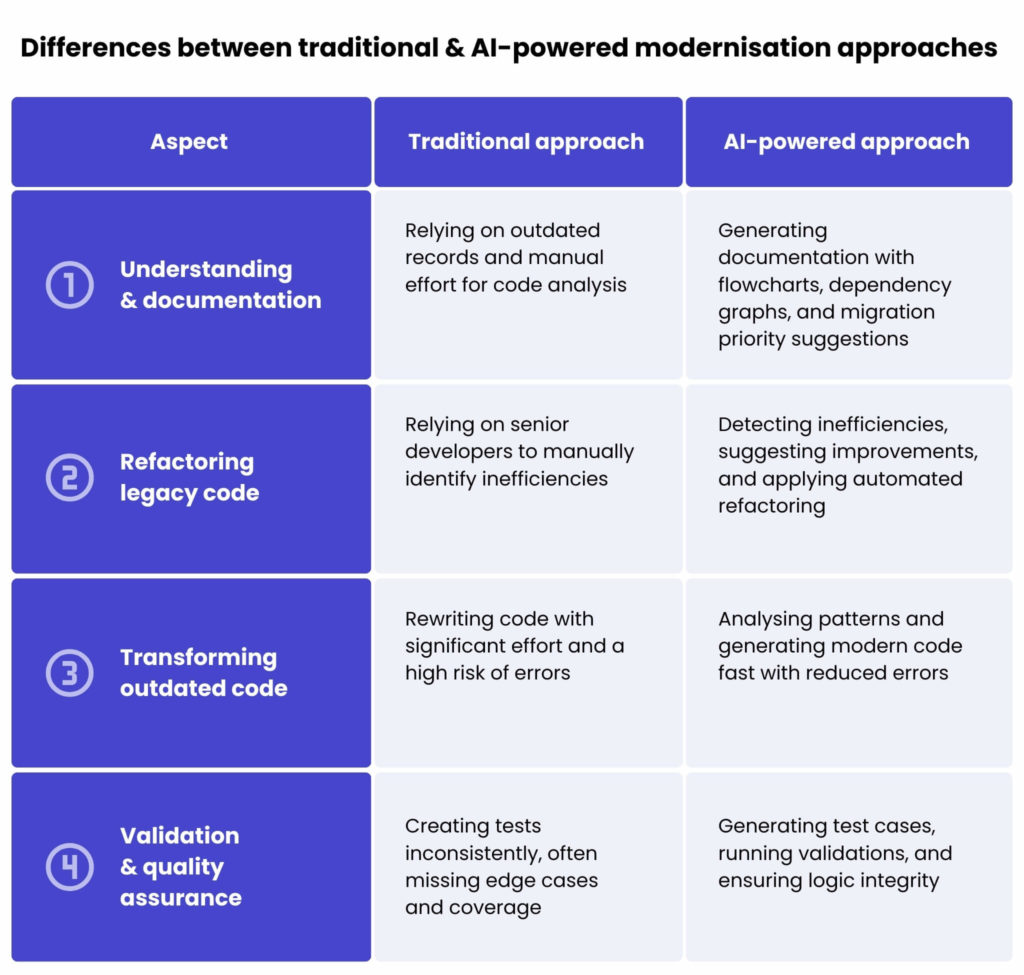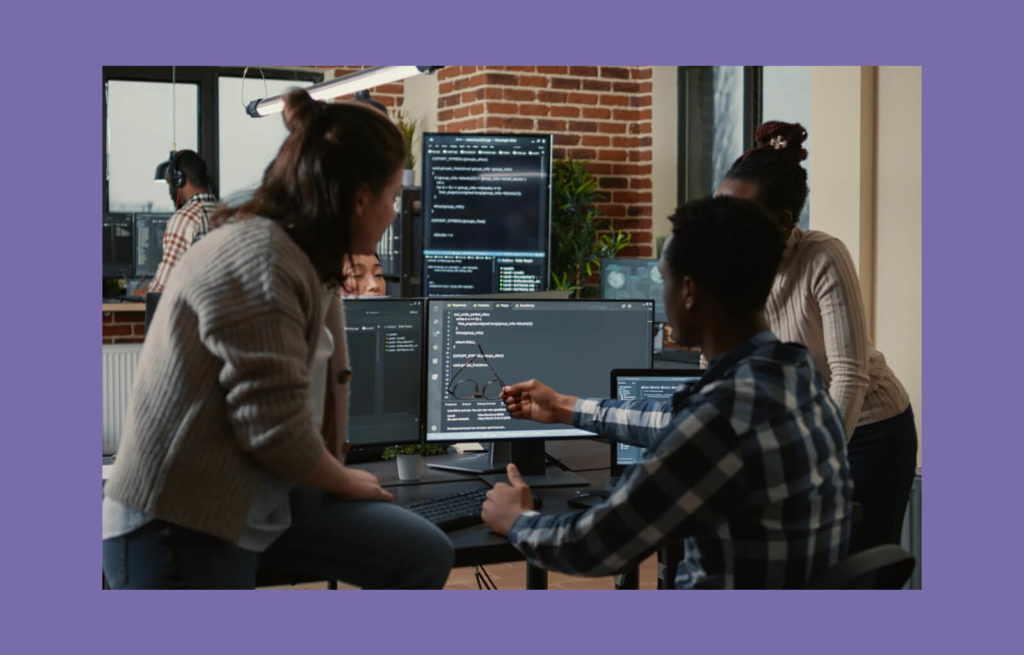How generative AI transforms legacy modernisation
Legacy modernisation is costly, complex, and often blocks digital transformation. No surprise that 74% of modernisation efforts fail – talent shortages, technical debt, and high costs stand in the way. Now, generative AI is changing the game, removing the biggest obstacles and making the process faster, cheaper, and more reliable. This article explores why traditional methods fall short and how AI can help you modernise efficiently.
For decades, enterprises have relied on legacy systems to run critical operations. However, as technology evolves, these systems can become a burden – expensive to maintain, difficult to upgrade, and a major blocker to your digital transformation.
It’s no wonder that transforming legacy systems has historically been challenging and expensive. You might have encountered issues that slow down or even derail your efforts.
Businesses recognise the need for modernisation, and most have attempted it, but traditional approaches have often failed.
74% of organisations admitted to starting a legacy system modernisation programme but failing to complete it in a survey conducted in 2020, highlighting the challenges companies faced before AI tools became widely available.
Source: Business Barometer Report, Advanced – Mainframe Modernization Report, 2020
Now, generative AI shifts the focus. You no longer need to ask whether your legacy systems can be modernised, but rather how quickly and efficiently you can do it.
Why does legacy modernisation fail?
Enterprises across industries, including banking, insurance, and government, know they need to modernise. Yet, most efforts stall or fail due to three key challenges.
Challenges of legacy systems
- Shrinking talent pool – Engineers with deep knowledge of legacy systems are retiring. Meanwhile, younger developers are not trained in outdated technology and languages. This knowledge gap makes maintaining and upgrading these systems increasingly difficult.
- Cost and complexity – Manually rewriting legacy software requires years of effort and substantial financial investment. You may have abandoned modernisation initiatives halfway through due to rising costs and uncertain outcomes.
- Accumulated technical debt – Legacy systems are deeply interconnected with outdated systems, making it difficult to untangle dependencies without disrupting core business functions.
As a result, you remain locked into rigid, outdated infrastructure, unable to scale or compete with digital-first businesses.
The importance of legacy application modernisation cannot be overstated, as transforming these outdated systems is crucial for enhancing organisational efficiency and competitiveness.
Choose the right approach to modernise your legacy systems
This is where generative AI comes in. Automating the most complex and time-consuming aspects of the process lets you overcome traditional roadblocks that have led to project failures in the past. Choosing the most appropriate modernisation strategy depends on factors like system complexity, budget, and risk tolerance.
Remember that AI doesn’t replace human expertise – it rather enhances it by automating the most complex, time-consuming tasks.
What can you do with AI-driven legacy system modernisation?
AI lets you:
- Analyse and understand legacy codebases at scale
- Refactor and optimise inefficient code
- Transform outdated languages into modern, maintainable code
- Accelerate validation and testing with automation
This structured, AI-assisted approach reduces manual bottlenecks and accelerates progress – alongside human expertise, ensuring your modernisation projects are completed quickly and successfully. Moreover, it lets you save costs. According to Gartner, AI-driven modernisation is projected to reduce costs by up to 70% by 2027.
The four aspects of AI-driven legacy modernisation
1. Understanding and documentation
One of the biggest challenges in legacy modernisation is a lack of documentation. Systems that have been running for decades often have limited or outdated records, making it difficult to understand dependencies and workflows within the existing system. AI automates it by analysing legacy code, mapping dependencies, and generating system diagrams.
For enterprises, this means significantly faster onboarding for developers and a clearer roadmap for modernisation. Companies using AI-driven documentation tools report up to 50% quicker developer onboarding.
2. Refactoring legacy code
Decades-old codebases are often inefficient and hard to maintain. Software modernisation is crucial for rejuvenating legacy applications, making them more efficient and aligned with contemporary business demands.
AI identifies redundancies and detects inefficiencies. It then suggests optimisations, resulting in cleaner, more maintainable code. This structured approach not only improves system performance but also reduces long-term maintenance costs and technical debt.
3. Transforming outdated code
Instead of manually rewriting thousands of lines of legacy code, AI automates the transformation process by integrating new technologies. It analyses patterns in existing systems, converts outdated languages into modern equivalents, and ensures logical consistency. This approach accelerates modernisation while minimising errors.
One of the most obvious indicators is the percentage of code that’s now written by AI. I ask all the software companies I meet about this. The number is rarely lower than 40%. For some young programmers, it’s 90%.
Paul Graham, computer scientist, writer, and venture capitalist
4. Validation and quality assurance
Modernising a system is only successful if it performs reliably after the transition. AI automates validation by generating test cases and identifying vulnerabilities. This ensures higher system reliability, lower defect rates, and a seamless transition to modern infrastructure.

Case study: automated documentation and knowledge retrieval
A global staffing solutions provider faced a significant challenge: 25 years of fragmented legacy system documentation spread across multiple platforms. The lack of centralised knowledge made system maintenance inefficient and posed a high operational risk.
To solve this, AI-driven documentation tools mapped out the entire system architecture, creating clear visual diagrams and automated reports. Knowledge retrieval tools further streamlined the process, reducing search time from hours to seconds.
The impact was immediate. Onboarding new developers became faster, reliance on tribal knowledge decreased, and overall operational efficiency of business operations improved.
Watch the full story:
AI is the future of legacy modernisation
Modernising legacy systems no longer has to be slow, costly, or high-risk. AI-driven transformation enables you to modernise faster, reduce costs, and eliminate technical debt. With AI solutions, you can fast-track transformation efforts, reap significant cost savings, and stay ahead of your competition.
The longer you delay, the more operational inefficiencies, talent shortages, and security vulnerabilities you will face. The time to act is now.
Contact Spyrosoft’s experts to learn how AI can transform your legacy systems into a modern, scalable solution – fill out the form below!
FAQ
If your systems are slow, difficult to integrate, expensive to maintain, or vulnerable to security risks, it’s time to modernise. Other signs include frequent downtime, limited scalability, compliance issues, and a shrinking talent pool for maintaining legacy code.
Yes. AI-driven legacy modernization project enables gradual transformation, meaning systems can be updated in phases rather than through a high-risk, all-at-once migration. This minimises downtime and business disruption.
Not necessarily. In many cases, AI-powered refactoring and incremental updates can extend the life of your existing system while improving performance. A full replacement is only needed if the system is completely outdated, insecure, or incompatible with modern business needs.
Industries that rely on complex, mission-critical systems (including banking, insurance, healthcare, manufacturing, and government) see the biggest benefits. AI helps these sectors transition from outdated infrastructure to more agile, scalable solutions.
AI tools help ensure compliance by identifying security vulnerabilities, enforcing coding standards, and automating regulatory reporting. This is crucial for industries with strict data protection and security regulations.
About the author
Contact us





